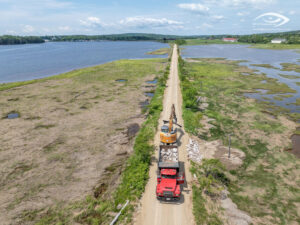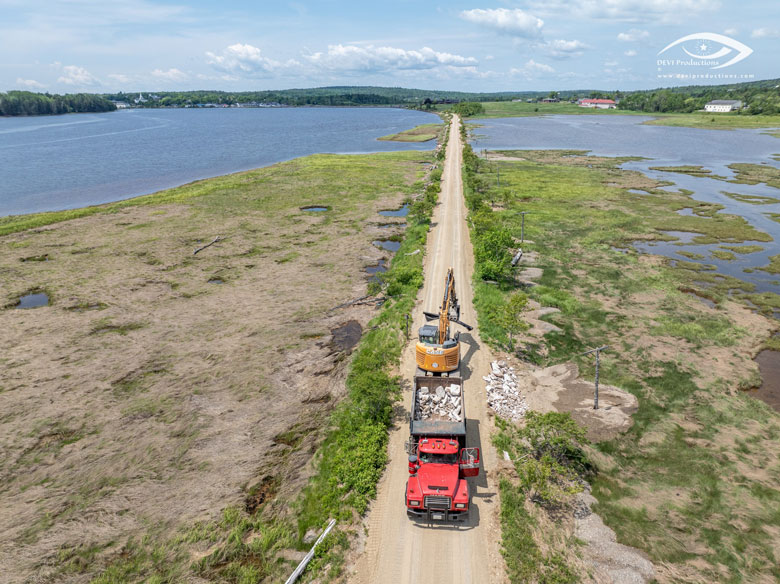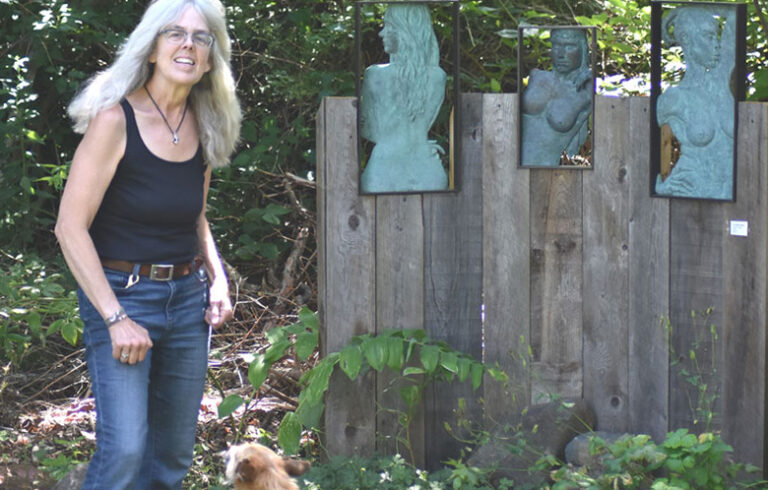
In its prime, a train ride on the Calais Branch Railroad corridor offered unparalleled scenic views. Stretching between Brewer and Calais from 1898 until 1984, the line carried freight and passengers alike, including President Franklin Delano Roosevelt and his family on their way to Eastport to embark for Campobello Island.
As the train traveled through Machias and East Machias, the Roosevelts would have seen nothing but the Machias River out their windows, with the rail line twisting and turning only feet from the water’s edge before bending inland again.
Today, those breathtaking water views remain, but instead of trains, it’s people walking, on ATVs, cycling, and even horse riding enjoying them. This is thanks to the train line’s 2009 transformation into the Down East Sunrise Trail, an 87-mile multi-use trail that uses the former rail line between Ellsworth and Ayer’s Junction in Pembroke, opening up the natural beauty of Hancock and Washington counties to a new generation of adventurers.
If approved, the bond would make grants available to help Maine nonprofits, municipalities, and other entities improve trails.
But the trail’s water views turned into a liability when December and January storms pummeled the Maine coast, breaking through wide sections of the trail in Machias and closing it to all traffic. The closure underscored the trail’s vital economic role in the region, and its potential to impact local businesses and tourism.
“It is arguably the most beautiful section of that trail,” said Machias Town Manager Bill Kitchen. “When the river breached, it was immediately clear to me that we were looking at an economic issue, not a recreation issue, and I was concerned that fixing the trail would take months and months to rectify.
Kitchen reached out to the Maine Department of Transportation, which owns the trail, and private and state stakeholders.
“Everybody seemed to understand that there is, essentially, a four-month window that a lot of local businesses count on,” Kitchen said. “And everyone seemed to understand we had a deadline to be finished by June 26, before the Machias ATV Jamboree.”
DOT bid the work May 8 and awarded it six days later to Hanscom Construction of Marshfield for $438,975. Using the finesse required to navigate massive dump trucks safely along a waterside rail bed, and despite tidal delays, Hanscom completed the work more than two weeks ahead of schedule, on June 7.
“I have never seen anything like this. How does something like that happen in a matter of 12 weeks, start to finish? It’s crazy,” Kitchen said. “Amazing.”
The unusual attention to speed might reflect growing statewide recognition of the trail’s importance to Hancock and Washington counties, but also of recreational trails to Maine’s overall economy. In November, Maine voters will be asked to consider a $30 million bond to repair and enhance trails across the state.
If approved, the bond would make grants available to help Maine nonprofits, municipalities, and other entities improve trails.
“This would be the first statewide designated trail funding that Maine’s trails have had,” said Alvion Kimball, president of the Sunrise Trail Coalition, a nonprofit that promotes outdoor recreation, health, and fitness. “Maine needs this bond because we’re a tourist destination, and outdoor recreation is a burgeoning focus for our tourism business.”
Sandi and Ryan Malagara own one of the Machias tourism businesses that rely on the trail. Crows Nest Rentals offers ATV rentals and opened the same year as Downeast Adventures on the other side of Machias, which also offers ATV rentals.

Both businesses have easy trail access and both report a steady clientele.
But the trail could be so much more to the region, said Sandi, because it’s unique.
“I hear from people who have gone to other trails, and they say the Sunrise Trail is amazing. It’s well-maintained, and it has so many more off-trail opportunities,” she said. “It’s got great potential, and it could be one of our greatest assets, but we need to find a way to promote it.” She also is president of the Machias Bay Chamber of Commerce
Besides being one of Maine’s longest multi-use trails, the Down East Sunrise Trail is also the longest off-road section of the epic East Coast Greenway, a trail that runs through 15 states starting in Key West, Florida, and ending in Washington County.
Soon, the Sunrise Trail could become even longer. The state’s Rail Use Advisory Committee (RUAC) is investigating the possibility of extending the trail 12 more miles to end near Calais.
“This extension was planned as part of the original Sunrise Trail. It was supposed to come all the way to Calais,” said Mark Carr, chairman of the RUAC, which was convened by the legislature. “For multiple reasons, some financial, some political, it never got finished.”
Eight miles of the possible extension run through the federal Moosehorn National Wildlife Refuge.
“Moosehorn has been great to work with, and if the decision is made to extend the trail, it’s going to be a beautiful ride through there. I didn’t realize just how beautiful until we went through it,” Carr said.
“I’m interested in extending the trail for the economic impact, really. I see what the trail has done for Machias for the last five years,” said Carr. “You can’t go there and not see a fleet of ATVs in town.”
The Sunrise Trail Coalition estimates ATV riders make up about 70% of users, many members of local trail clubs.
But around the towns that intersect the trail, like Ellsworth, Franklin, Cherryfield, and others, the trail sees more non-motorized users, like walkers, runners, cyclists, and even horseback riders.
As an Island Institute Fellow with the Sunrise Trail Coalition, Lavinia Clark is currently at work on the Down East Sunrise Trail Village Access Project which will create a bicycle and pedestrian access plan for trail users around eight Hancock and Washington County towns.
“Growing up I spent a lot of time in the White Mountains of New Hampshire, biking, hiking, running, and skiing,” said Clark.
“The most unique thing about the Sunrise Trail is that it goes through several downtowns. So now we’re thinking about the pedestrian and cyclist spheres and asking, ‘How can we improve the experience for them?’”
This summer, Clark assisted in the work of a University of Maine at Machias student, Alicia Jonah, who created a project to offer more rest areas for people traveling along the trail’s Machias and East Machias sections.
“She was looking for a way to make the trail more accessible to folks just interested in going out for a 10- or 20-minute walk. She went out and found local business sponsors to pay for the benches,” said Clark.
“They’re all interested in investing in the trail and making the trail more enjoyable for community members, and that is really, really wonderful,” she said.





